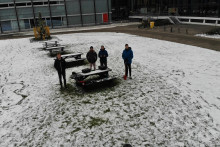Landmines represent a huge risk worldwide. It is estimated that more than 100 million mines pose significant hazards in nearly seventy different countries. In 2021 alone, over 5,500 people were killed or maimed by landmines, half of whom were children. ‘We want to reduce these dangers by using technology,’ says Alberto Martinetti who leads the project on innovative landmine detection at the UT Humanitarian Engineering Research Group.
Lengthy process
‘In many places, landmines remain after years of conflict, but removing them is a lengthy process,’ says Martinetti. ‘Demining currently needs to be done manually by a specialized operator. The operator has to walk through the mine fields, locate the mine, determine what type of a mine it is, deactivate it, and then remove it. This is often done using a metal detector or other methods, such as specially trained dogs. As you can imagine, this procedure is very lengthy, costly and dangerous.’
UT scientists are therefore looking for a solution to make landmine detection faster and safer. ‘We are directly collaborating with Sheild Association, a civil society organization which works in Lebanon and Syria. They will now work on detecting and removing mines in Syria, because people want to return to their home country after the war – and they want to go back no matter what. Even if there are still mines near their homes. This is not a very desirable situation, and so we are looking into using technology to speed up this process,’ explains Martinetti.
In order to come up with a solution that is effective as well as affordable, the researchers aim to combine existing technologies, such as drones, thermal cameras and ground penetrating radar. Ultimately, drones could be deployed above mine fields and automatically detect mines, which could then be safely removed.
'We want to come up with a reliable and affordable solution' - Alberto Martinetti
Field test on campus
To test if this idea had any potential, the UT scientists needed to do a field test. Because going straight to Lebanon or Syria would be too difficult, they organized a test directly on UT campus, on a grass field behind the Horst building. They created plastic replica mines, including materials to mimic the heat signature of explosive substances, and buried them in the ground alongside other objects. With the help of the UAV Centre at the UT, they used drones to fly over the area and acquire needed data. ‘We wanted to understand if these materials have a distinctive thermal signature that we can detect,’ explains Martinetti.
The results varied depending on the type of landmine. ‘Most landmines are made of metal, but there are some that are made of plastic, and some older ones are made of wood,’ clarifies Martinetti. ‘Based on the initial results, we could see that the metal landmines were easier to spot. The wooden and plastic mines, on the other hand, were hard to detect because their temperature was similar to the temperature of the soil.’

On the left: image obtained by the drone in combination with a thermal camera. On the right: the landmine replica buried in the ground on UT campus.
In different conditions and daylight, however, the results might be slightly different, adds the researcher. ‘Naturally, we had very different weather conditions than there are in Lebanon or Syria. While those countries tend to be very warm, we did our field test in January in freezing temperatures. That makes the whole test more complicated to validate.’
More testing
The next step therefore is: a lot more testing. The first field tests were part of the bachelor assignments of UT Mechanical Engineering students Robin Bevers and Jelte de Vries, and two follow-up projects are already lined up. The goal is to apply ground penetrating radar, as well as thermal cameras. The researchers also plan to incorporate automatic detection, so that the drone could simply locate the landmines and pass on this information to the operator. ‘To test all this, we will need to conduct more field tests – in different terrains and weather conditions and using different cameras,’ says Martinetti.
Eventually, the solution will also need to be tested directly in Lebanon or Syria together with Sheild Association. ‘The ultimate goal is to provide effective tools for landmine detection. We want to come up with a reliable and affordable solution, which Sheild can easily deploy,’ says Martinetti. ‘Landmines kill thousands of people every year. We want to speed up the detection of landmines and make the process much safer.’







